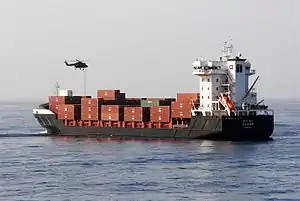Action of 5 April 2010
The Action of 5 April 2010 was an action by the Royal Netherlands Navy to free the container ship MV Taipan that had been taken by Somali pirates. It occurred during the European Union's Operation Atalanta.
| Action of 5 April 2010 | |||||||
|---|---|---|---|---|---|---|---|
| Part of Operation Atalanta | |||||||
 Lynx helicopter above MV Taipan | |||||||
| |||||||
| Belligerents | |||||||
|
|
| ||||||
| Commanders and leaders | |||||||
|
|
| ||||||
| Strength | |||||||
| 1 frigate |
1 mothership 2 skiffs | ||||||
| Casualties and losses | |||||||
| 1 wounded | 10 captured | ||||||
Action
A group of ten pirates successfully boarded and hijacked the German-flagged and owned MV Taipan 500 nautical miles (930 km) off the coast of Somalia on 5 April 2010 from two attack skiffs. The crew of 13 were able to lock themselves in a secure location after shutting down the engines and immobilizing the ship. They then contacted international naval forces in the area. The Dutch warship HNLMS Tromp was sent immediately to the scene. Aerial reconnaissance showed that pirates were indeed on board the merchant ship, and showed their two skiffs in tow behind it. As Tromp approached, its sailors spotted a pirate mother ship heading towards Taipan, probably to bring in reinforcements. After a radio warning received no response, Tromp fired several warning shots at the mother ship, which then turned around and fled the scene.
All attempts at negotiation failed, and when it became clear that the pirates intended on resisting, it was decided to free the ship by force. A rescue operation was permitted after the warship contacted authorities in the Netherlands and requested permission. Dutch Marines from the Unit Interventie Mariniers rappelled down from Tromp's helicopter onto containers on the ship's deck under the cover of machine gun fire from the helicopter.
The Marines initially fired on the pirates, then stormed the pirate-held areas. All ten Somali pirates quickly surrendered, and were taken into custody, and all of the hostages were freed safely. None of the Marines were wounded by enemy action, though one of the Marines was confirmed to have sustained light injuries from "other causes".
One of the Marines participating in the raid had attached a helmet camera onto his helmet, and captured the entire rescue operation on film, including actual footage of areas being searched and pirates surrendering. The video was released by the Ministry of Defence, and was shown on Dutch television. It became a popular video on the internet, especially YouTube.
References
| Wikimedia Commons has media related to Liberation of MS Taipan. |

